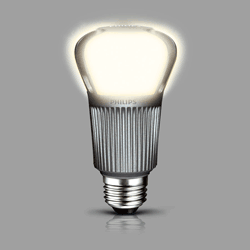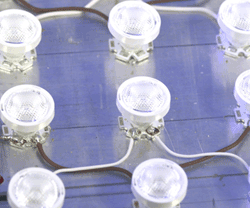Innovative SSL design in a retrofit package is allowing engineers to create incandescent-equivalent lighting with a long life at a fraction of the power
BY MICHAEL J. KAWA
It is safe to say a technological shift is in the making for home lighting. In less than three years, most A-type incandescent light bulbs will be phased out of the U.S. marketplace as new federal minimum efficiency standards go into effect in an effort to reduce electrical consumption and reduce pollution from CO2 emissions.
Compact fluorescent lights, long touted as the heir apparent to fill this void, are now being viewed as an interim technology by many leading manufacturers, mainly due to the explosive growth and potential of solid-state lighting.
Commercially available LEDs are now producing unprecedented luminous efficacy values of 160 lumens/W and light output power in excess of 1,500 lumens. Coupled with their inherent longevity and low-energy usage, they are becoming ideal choices for many commercial and industrial lighting applications.
In home lighting, LEDs have filled many niche applications such as spot, accent, and down lighting, but their next evolutionary milestone is an equivalent replacement for the common household incandescent light bulb.

The EnduraLED light bulb from Philips produces 806 lm using 12 W of electricity, for an efficacy of 67 lm/W This replacement for the 60-W incandescent bulb uses 80% less energy and should last 25 times longer.
While the concept of an LED based light bulb sounds simple it isn’t easy. These complex devices integrate LEDs, power supply, drive circuits, and heat sink into a compact retrofit housing that screws into a standard Edison-based light socket. Yet to be successful, they must satisfy two main design issues: light quality and heat removal.
Matching the light characteristics of the incandescent bulb
One of the most challenging obstacles designing an LED light bulb for mass acceptance is the need to match the familiar warm glow and intensity of the incandescent bulb. This means duplicating the brightness, white color quality, and illumination pattern so that it will not only meet lighting requirements but also be aesthetically pleasing to consumers.
Comparatively, the light source for LED-based bulbs are white-light LEDs. They are made by using a monochrome blue emitter die coated with a yellow phosphor that produces white light. These phosphor-based LEDs have high color temperatures and lower efficiencies which have characteristically produced a moderate-intensity white light with a cool blue appearance.
For white-light LEDs to match the light characteristics of the incandescent bulb, designers needed to increase their luminous intensity and alter their color quality. One area of innovation that is making this possible is remote phosphor technology, which uses a proprietary technique, from the Lighting Research Center at Rensselaer Polytechnic Institute (Troy, NY), called Scattered Photon Extraction. This process applies the phosphor coating to a small disc placed a short distance above the blue emitter die, allowing scattered light from the conversion process to be recaptured and reused by secondary optics. This technique to recycle scattered light has resulted in groundbreaking increases in light output power and luminous efficacy.
Other methods to increase light output include altering the surface of the die to reduce internal reflection, using LED modules containing arrays of multiple smaller dies, which increases light extraction from peripheral side walls, and the using innovative design architectures like thin-film flip-chip.

The single-chip XLamp XM LED from Cree uses an advanced thermal design to deliver a record-breaking efficacy of 160 lm/W at 350 mA.
Improvements to white color quality have also been made by changing the mix of the phosphor coating. Adding red or green phosphors can produce lower color temperatures with optimized color rendering, resulting in warmer white tones. Specific phosphor mixes can be created to simulate color temperatures produced by different-wattage incandescent bulbs. Improved coating methods apply consistent phosphor densities and thickness levels across the disc to ensure uniform color quality.
To imitate the wide beam illumination pattern of incandescent bulbs, designers need to overcome the characteristic narrow-beam illumination of LEDs. This issue is addressed by taking advantage of their available viewing angle configurations and small form factor, which allow designers to mount multiple LEDs or LED array modules on a flat surface or a preshaped base inside the bulb to direct multiple beams where the light is desired or will be most effective. Designers can create a saturated central beam with peripheral support to mimic a spotlight or have more equal spacing to give off a wider spatial radiating pattern similar to a standard incandescent. Additional optical components like reflectors, lenses, diffusers, and the bulb dome itself can be used to further control or enhance the LED.
Thermal management of the p/n junction
Unlike incandescent bulbs that radiate 90% of their output energy as heat, LEDs do not experience traditional IR losses and run relatively cool. However, heat is generated at the p/n junction of each LED, and it must be removed to ensure proper operation. Any excessive heat at this junction will severely degrade the LED light output and usage life.
One of the basic design conundrums for engineers is to remove the heat generated at the p/n junctions while maintaining the power levels necessary to operate the LEDs — all within the physical size and shape constraints of the traditional bulb and the efficacy limitations of currently available LEDs.
To obtain the necessary surface area to dissipate the heat, designers use the hollow neck of the bulb as a heat sink. It is typically made of an aluminum or magnesium-alloy base in a grille or ridged style to facilitate the quick transfer of heat to the ambient air. Resourceful designs add surface area and directional spread by using heat sink fins or arms that wrap around the sides of the bulb (without impeding illumination).

The heat sink for the GE Energy Smart LED bulb uses a unique finlike design to remove heat from the internal LEDs while preserving uniform light distribution.
Recent heat-sink innovations use a high-thermal-conductivity resin (which can dissipate heat on par with aluminum), making the entire bulb housing plastic except for the base. This reduces the weight of the bulb and increases design flexibility since it can be easily molded.
Internally, a metal backing plate or thermal interface can be used to transfer heat from the LED circuit board to the heat-sink base through direct mounting or a thermal compound. Additionally, heat from the isolated internal electronics and power circuitry inside the hollow bulb neck can be transferred directly to the heat sink through a thermally conductive encapsulating material. ■
Advertisement
Learn more about CreeGE LuminationPhilips Lumileds





